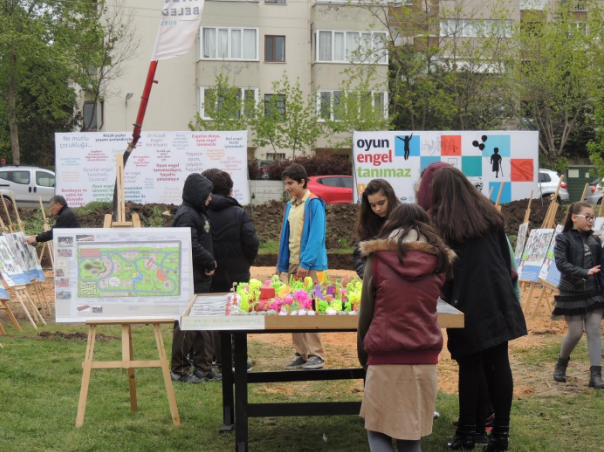
Children as not just players, but also designers of the urban playground
The exhibition of the playground design & ground-breaking of the project
My paper at Ghent 2016 will look at a long-term, participatory, built-environment education programme whose aim is to spread urban culture among children, enabling them to experience the joy of designing, both for themselves and for the rest of their society; convincing them that their ideas are valuable by realizing their dream-project. First, though, the programme had to demolish all kinds of barriers…
The built environment is generally assumed to be solely vocational issue. In fact, the users of space, ordinary citizens, have a major role in determining the shape of urban environments; even more so than professionals. This is because urban environments are like living creatures, evolved and shaped by their use. It follows that all users and inhabitants of the urban domain should be well-informed about the built environment, and have opportunities to be involved in participatory projects. In so doing, their ideas and aspirations can better influence their own life circumstances; they may even find opportunities to change the physical conditions of their urban environments.
Play Without Barriers (PWB) is a child participation project combined with a built environment education model. The project takes place in the Nilüfer District of the city of Bursa, Turkey. Participants are chosen to design an inclusive playground where all users can feel themselves involved. They are aged between 8-14 years old, the most appropriate age group to learn and benefit from built environment education, as well as being the obvious potential user group for playgrounds. All participants are also either residents of the local neighbourhood or students at nearby schools. There are a total of thirty participants, six of whom are disabled. In this way the needs and desires of children with different physical capabilities might be considered and equality of opportunity promoted.
The most distinctive aspect of PWB as a participatory built environment education programme is building an urban space according to the design supplied from children’s own work. There are many stakeholders in the project, including Nilüfer City Council as the coordinator, Nilüfer Municipality, NGO’s and academics from several universities and departments. This diversity of stakeholder groups makes it possible to nourish different aspects of the project and supports its participatory approach.
As an architect and academic, the author is the educational coordinator of the PWB program. This includes structuring a 28 week-long educational schedule and instructing the design studio phase. Following the design process, it is the educational coordinator who mediates between participants (children) and the stakeholders who are responsible for building the playground based on their design. Thereafter, the main facilitator of the application phase of the project is the municipality.
From the beginning of the project, PWB aimed to raise awareness of urbanism and citizenship, empower urban youth to take actions on urban issues relating to the public realm. PWB achieved most of these goals by strengthening the perception of the commons, enabling children and young people to represent their demands for the built environment, and to advocate their own solutions to the problems they identify, encouraging participants to enhance their civic engagement with urban life.
Author: Sebla Arin
Photo Credit: photo by Sebla Arin
Interested in hearing more on Sebla’s research? Join us at the Child in the City Conference in Ghent, Belgium on the 7-9 November!
View our conference website here!




